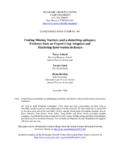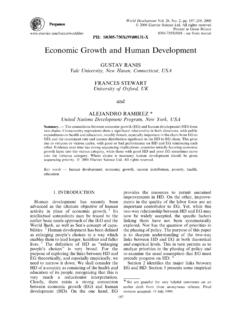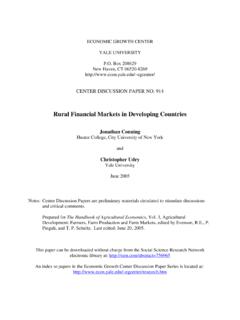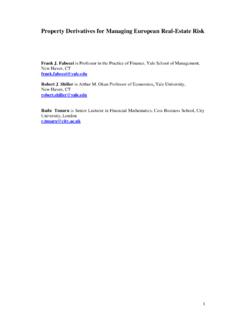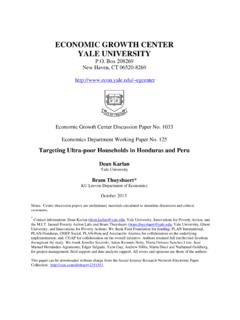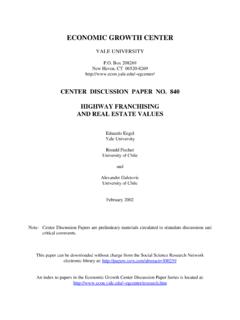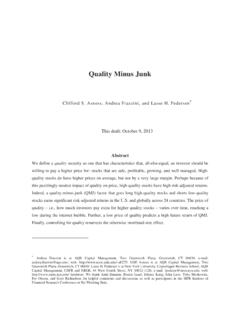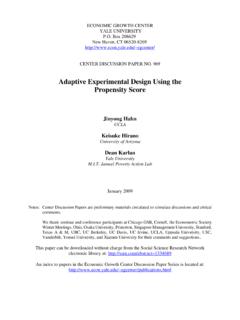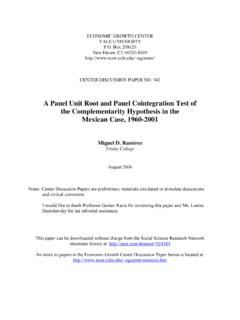Transcription of “Structural vs. Reduced Form” - Yale University
1 Structural vs. Reduced Form Language, Confusion, and Modelsin Empirical EconomicsPhil HaileNovember 20211 Types of Empirical Economics?1. Measurement how much do prices change with the number of competitors? how has productivity ( , TFP) in the auto industrychanged over the last 30 years? what is the effect of college attendance on expected wage? what is the elasticity of demand for health insurance in MA?2. Model Testing is there moral hazard in auto insurance? does BNE explain bidding at oil auctions? do actual contracts resemble optimal contracts?3. Model Estimation for Counterfactuals how much would prices rise two firms merged? if the sales taxincreased by 1%? how would student outcomes differ under a different schoolchoice mechanism?
2 2 Measurement vs. Model Estimation for Counterfactuals This distinction isusuallyfalse: Most measurement questions ineconomics concern a counterfactual of the form how would theworld have been different if XXX were changed, all else fixed? effect of entry on prices:we can t just compare markets withdiffering numbers of competitors productivity: we can t just look at inputs and outputs to learnthe production function (and thus TFP), since unobservablesaffect both the input levels chosen by firms and their realizedoutput returns to college: we can t just compare wages for those whoattended and those who did not elasticity of demand : we can t just compare quantitiespurchased for goods with high prices vs. those with low and CounterfactualsMuch of empirical economics is about causal effects (what we once just called effects )Causality is a concept defined by a counterfactual question of theform what would happen if certain things were changed whileothers were held fixed?
3 This is true even for a RCT. There, after defining the counterfactual questionof interest, one directly creates the counterfactual world , assigning drugsrandomly instead through the mix of decisions that would otherwise the counterfactual question of interest is simple; but only afterdefining the question can one ask how to design the RCT to answer of Empirical Work: A Proper : estimate relationships between observables establish facts about the data, ,college grads earn 98% more per hour than othersincome inequality higher now than 30 years agohealth care costs growing more slowly after ACAairline prices higher now than before merger wave facts sometimes suggest causal :estimate features of a data generating process( , a model) that are (assumed to be) invariant to thepolicy changes or othercounterfactualsof interest estimate demand for schools predict outcomes under avoucher system estimate model of schooling, marriage, and labor supplychoices measure specific notions of the male-female wage gap estimate demand and firm costs predict effects of a merger (model testing=special case).
4 5 What about Program Evaluation?Consider a RCT with interest only in the effect of the treatment inthe population , program evaluation isdescriptive:it involves only acharacterization of relationships between is alsostructural: it quantifies features of the underlying( causal / structural ) model characterized by the jointdistributionF(Y,D,X)whereD {0, 1}indicates treatment,Ymeasures outcome,Xare controls. 6 Program Evaluation, Counterfactuals, ModelsProgram evaluation (indeed, any type of causal inference ) isalways a form of structural estimation. It requires a set ofmaintained hypotheses about the world ( , a model) allowing onetodefineandidentifya counterfactual quantity of , ATE, LATE, QTE, etc. are all precisely defined only under awell specified model of how the data are being generated.
5 Anysuggestion that these objects are model free is Evaluation is Structural EstimationSometimes ( , in RCT) data description directly reveals acausal/structural/countefactual quantity like TT. But that is aresult one that follows from an explicit set of assumptions on theunderlying structure that allows us to distinguish the notion of TTfrom others and to logically conclude that the data directly revealthis program evaluation requires more than descriptiveanalysis: one must counterfactually hold all else equal to learn thetrue effect(s) ofDonY, givenX. This means treatingF(Y,D,X)(or a functional ofFlike LATE) as the counterfactualquantity of interest and using appropriate econometric techniques(IV, diff-in-diff, RD,..) to estimate Causal Models Mainly Old Wine in New BottlesA causal effect is just the responses to ceteris paribus changestaught in Econ101 concept central to economics since Alfred Marshall.
6 Second nature toeconomists. Estimation of such effects has been a primary focus of empiricaleconomics from the earliest years of econometricsDisciplines lacking natural models invented new ones , the POframework/Rubin causal model or the DAG/SCM models of Pearl to defineand explore counterfactual quantities of interest. These models can be veryuseful, and one can certainly have preferences over modelsBut such preferences are the only real distinction: causalidentification/estimation/inferenc e is always a special case of structuralidentification/estimation/infe rence as defined in econometrics 70+ years and ScienceIt is great that more economists are interested in empirical that new techniques have been developed. Great that thestandards for convincing ( credible ) empirical work have re-branding of an old product ( , effect causaleffect) is useful marketing that stimulated new relabeling doesn t change anything on its own.
7 Unfortunately,many (even very accomplished) people are misled or confused byre-labeling of established concepts or alternative uses of establishedterminology. This is bad for Final Observation about CounterfactualsA counterfactual may involve a feasible policy change ( , raisethe minimum wage). But it could instead be a purely artificialnotion ( , change women to men to see the resulting wagechange).As always, one must think carefully about the counterfactual ofinterest: , woman switched to man at age 25? at birth? Butthose suggesting that one cannot define the (causal) effect of beingfemale rather than male are confused. A hypothetical policyintervention is often a good way to think about a counterfactual,but it is an illustration of the concept, not its about Reduced Form ?
8 Formis a functional or stochastic mappingfor which the inputs are (i)exogenousvariables and (ii)unobservables ( structural errors ), and for which the outputs areendogenousvariables. ,Y=f(X,Z,U).This is the textbook definition and the only formal definition I amaware of. In econometrics this goes back at least to does it come from?Formally, a Reduced form is obtained by solving a (structural)model for each endogenous variable as a function of the exogenousobservables and structural classic example is perfectly competitive supply and demand ina one-good economy:Q=D(P,X,Ud)( demand )P=MC(Q,Z,Us)( supply)Solving for equilibrium yields the Reduced form relationsP=p(Z,X,Us,Ud)Q=q(Z,X,Us,Ud).13 Reduced Form: One Source of ConfusionSolving for the Reduced form isn t actually essential.
9 We just needto know what goes on which side and what restrictions, if any,must be might be difficult without writing down the structuralmodel(s) we have in mind. But logically one can hypothesize areduced form rather than hypothesizing structural relationships andderiving the Reduced Form: Another Source of Nuance and formis a functional or stochastic mappingfor which the inputs are (i)exogenousvariables and (ii)unobservables ( structural errors ), and for which the outputs areendogenousvariables. ,Y=f(X,Z,U).But what doesexogenousmean? for a theorist, an exogenous variable is one taken as given in(not determined within) the model for an econometrician: an exogenous variable is one satisfyingsome kind of independence condition with respect can be different: the fact that something is treated as given does not mean it satisfies any independence conditions!
10 15An Example: Monopoly Price and Quantity firm has marginal costc(q,t, )whereqis quantity,tisquality, and is a cost shock (unobserved shifter of costs) demandD(p,t, ), wherepis price, is a demand shock taking(t, , )as given, solve for eqm price and quantity:p (t, , )q (t, , )=D(p (t, , ),t, )The theorist s Reduced forms arep (t, , )andq (t, , ).From the econometrician s perspective, these may not be reducedforms becausetmay be correlated with( , ). For example,correlation is generallyimpliediftis chosen by the firm withknowledge of( , ). In that case,tcannot appear on the RHS ofa Reduced form econometric continuedSo there is a nuance. But the real issue in the example is that thetheorist s model left out something: howtwas may be fine for the purpose of the theory, but may mean thatthe econometrician has todevelop a richer modelin which more ofthe variables are endogenous.
